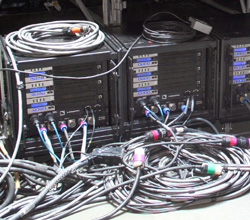
The common “wisdom” just a few years ago was that the emergence of self-powered loudspeaker lines with enclosure-mounted amplifiers and protection circuitry tuned specifically for the loudspeaker meant the days of rack-mounted power amplifiers were numbered.
But it’s funny the difference that innovation can make. Today’s amplifier is a powerhouse, light years removed from the huge, heavy and inefficient designs of the recent past. Current designs are also far lighter, and in some cases, come in a compact package that more resembles a rack-mount processor than a device capable of generating several thousand watts of audio power.
The addition of DSP into the package hasn’t hurt either, offering convenience, space and cost savings, operating efficiencies, performance advantages and more. It also seems that some users will always prefer their amplifiers on the ground, where they can be quickly and easily accessed if there’s need for service or repair. This is particularly true for live events, where the show must go on.
The primary advancement has been to make the brutes more efficient. Greater output efficiency means less heat, and therefore, less weight, as well as more AC power making it to the loudspeakers.
The most common amplifier topology now is Class D (and variations), which uses an on-off switching method for its transistors called Pulse Width Modulation. Because its output devices are either on or off, the efficiency of the amplifier is greatly increased, and this is done without jeopardizing the integrity of the audio waveform by switching positive and negative output transistors on and off many times per waveform cycle.
This method is analog, but similar in theory to digital sampling where a 44.1 kHz sampling rate is used to accurately capture a 20 kHz signal. This rapid switching creates a square wave that is then low-pass filtered to recreate the audio waveform.
ProSoundWeb offers dozens of articles regarding amplifier classes, designs, data, testing, applications and more. In the meantime, take our Real World Gear gallery tour of audio innovation, the modern power amplifier.
